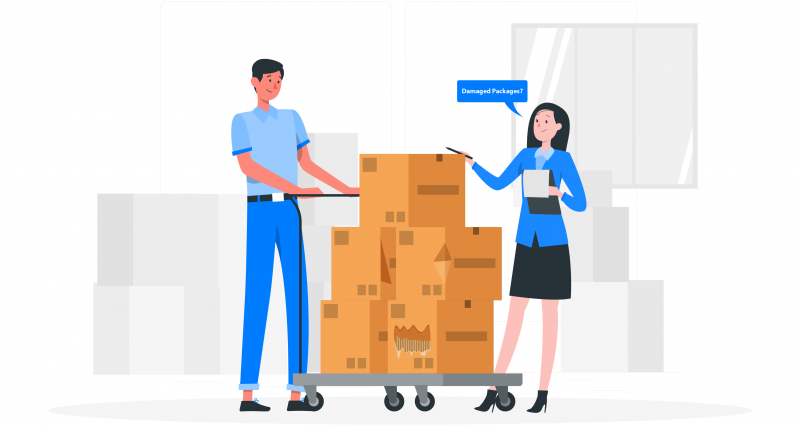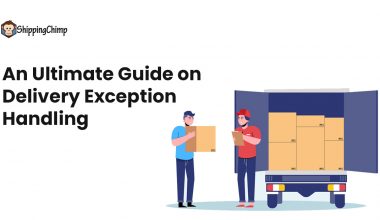The pandemic has had a debilitating effect on order-fulfillment.
Even major shipping carriers such as FedEx, UPS and USPS are struggling to handle sudden explosion in shipment volume. They have taken various steps to mitigate the impact on their fulfilment network. From suspending money back guarantees for expedited parcels to adding peak volume surcharges.
As an eCommerce business owner , you have to constantly deal with delivery delays, missing packages or damaged items. For getting the orders delivered intact to your customer is top of your priority.
However with the onset of pandemic, the last-mile delivery process has only plunged into deeper state of chaos. It is crucial for you to take complete control of order-fulfilment process.
In this article, we cover the following topics:
- With COVID-19 the number of damaged packages has increased. Why?
- How damaged goods can affect your customer experience?
- How do items get damaged in the first place?
- How to deal with damaged goods?
- Smarter ways for brands to handle damaged items
With COVID-19 the number of damaged packages has increased. Why?
Another side effect of the outbreak has been a sharp increase in the total number of damaged packages. Why?
- Higher than normal demand
- Less space on trucks due to lesser drivers
- More retailers selling items online that would be otherwise purchased in-store.
As a result, nearly a 20% increase in the number of damaged packages between February and March this year.
How damaged goods can affect your customer experience?
If your item is damaged during shipping and you don’t address the situation promptly and proactively, the outcome can be very detrimental:
- Loss of revenue on the current order— The shopper might refuse to make payments or contest the charges.
- Loss of future business from others— Consumers are going to express their displeasure via a number of platforms. If these get shared widely on social media it will cost you your future sales.
- Loss of future business from this customer— If the issue at hand is not resolved, he definitely won’t be purchasing from you again.
- Loss of standing with watchdog organizations— When too many customer service issues go unresolved you will find your brand reputation take a huge hit.
How do items get damaged in the first place?
If you are receiving a lot of returns because of faulty or broken products you need to first identify where things are going wrong. Here are a few possible reasons:
- Your items are not packaged properly— Often to cut costs, shippers use fewer packing materials or older boxes. While this may prove to be significantly cheaper for you it can also mean that the goods aren’t well protected. Hence are susceptible to damage easily.
- Mishandling by your carrier— Even if you are using a renowned, reputable company they have a lot of packages to deal with regularly which implies they probably are not always as careful as they should be.
- Poor warehouse conditions— There are a number of ways in which the products may be negatively impacted while in storage. Maybe, the temperatures aren’t right, or a bad location exposes your stock to tornadoes and floods. Moreover, low security could mean lots of theft, and so on.
- Adverse weather— Poor weather conditions can also damage your goods before they are received by your customers. Snow, rain and humid conditions can all weaken boxes and leave the items susceptible to damage.
Insurance
Often, firms tend to have cargo insurance which protects them against losing money for damaged goods. The insurer seeks recompense from the carrier of goods or the supplier. Once the claim is lodged the insurer can dispatch a surveyor to determine the authenticity of the claim. While carriers may have more limited options, shipping carriers like UPS, USPS, and FedEx offer optional shipping insurance for a sum of money. If you are shipping with FedEx for instance, you must know that their liability for damaged goods is capped at $100.
Returned by Customer
Companies can receive damaged goods from customers too. In that case, you are legally obligated to offer a replacement or a refund provided. Although, the customer must show a veritable proof of the purchase record like a bank statement. The extent of the damage can then be determined precisely.
Resale Option
Damaged goods from customers cannot be returned to the supplier. Especially if the original shipment was signed for undamaged. The item in this regard is definitely a loss-maker for your store. You may try to fix the damage and sell it at a marked-down price.
How to deal with damaged goods?
What does it mean to have an exceptional customer service response to damaged products? Indeed, it’s subjective and often difficult to ascertain. To help, here are a few steps that you can consider to turn disappointment into delight.
- Respond to the inquiry promptly— Ideally, within a few hours. If not, definitely by the end of the day if need be.
- Take full responsibility—While the shipper may be responsible for the damaged item, the shopper will hold you accountable. By reassuring your customer with an immediate replacement, you can gain their trust.
- Get as much information as possible— Talk to your customer directly and try and acquire as much information as you can from them. Ask them to provide detailed descriptions of the damage or snapshot.
- Expedite the replacement—Just a few extra bucks for faster shipping will just buy you a great amount of goodwill. Promise a prompt resolution and ensure you follow through on these promises.
- Provide an incentive for future orders—Ensure you include coupons or at least discounts with the replacement shipment. A subsequent purchase that goes smoothly coupled with your attentive handling of this issue at hand will earn future business and a loyal customer.
Smarter ways for brands to handle damaged items
In a world where COVID-19 has forced brands to make rapid changes to the business models, honest communication with the shoppers has never been more important. With the changing regulations, brands too are pivoting and shifting in reaction.
Here’s what you can do to help customers:
- Invest in an online portal within your shopping site where customers can initiate returns for faulty or damaged orders.
- Stay on top of order deliveries with real-time shipment tracking to intervene in case of delivery issues.
- Share delivery alerts or notifications with customers about all order-delivery-related details.
With ShippingChimp’s end-to-end last-mile visibility powered by AI, eCommerce stores can track, predict, engage, and deliver an exceptional customer delivery experience.
Ultimately, it is your responsibility to ensure your customer receives the package intact and on time. It’ll be in your best interest to go that extra mile for them. Damaged shipments are imminent when shipping in high volumes. Instead of letting it damage your brand reputation, flip the script to inspire and craft a memorable customer experience.
- Why Winter Shipping Is a Big Deal for D2C Cosmetics Brands? - December 18, 2025
- The Last Minute Customer Strategy: Handling Orders After the Carrier Cut-off - December 12, 2025
- Holiday Shipping Deadlines 2025: When to Ship for On-Time Christmas Delivery - December 3, 2025






